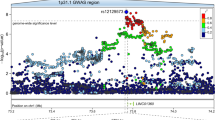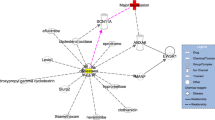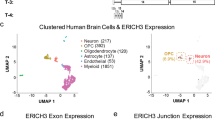Abstract
Norepinephrine released from sympathetic nerves is removed from the neuroeffector junction via the action of the norepinephrine transporter (NET). NET impairment is evident in several clinically important conditions including major depressive disorder (MDD), panic disorder (PD), essential hypertension and the postural orthostatic tachycardia syndrome (POTS). We aimed to determine whether a single nucleotide polymorphism (SNP) in the 3’ untranslated region (UTR) of the NET gene is associated with NET impairment and to elucidate the mechanisms involved. The analyses were carried out in two cohorts of European ancestry, which included healthy controls and MDD, PD, hypertensive and POTS patients. Compared with controls, cases had significantly higher prevalence of the T allele of rs7194256 (C/T), arterial norepinephrine, depression and anxiety scores, larger left ventricular mass index, higher systolic and diastolic blood pressures, and heart rate. Bioinformatic analysis identified that the microRNA miR-19a-3p could bind preferentially to the sequence created by the presence of the T allele. This was supported by results of luciferase assays. Compared with controls, cases had significantly lower circulating miR-19a-3p, which was associated with pathways related to blood pressure and regulation of neurotransmission. In vitro norepinephrine downregulated miR-19a-3p. In conclusion, the T allele of the rs7194256 SNP in the 3’UTR of the NET gene is more prevalent in diseases where NET impairment is evident. This might be explained by the creation of a binding site for the microRNA miR-19a-3p. A defect in NET function may potentiate the sympathetic neurochemical signal, predisposing individuals with affective diseases to increased risk of cardiovascular disease development.
This is a preview of subscription content, access via your institution
Access options
Subscribe to this journal
Receive 12 print issues and online access
$259.00 per year
only $21.58 per issue
Buy this article
- Purchase on Springer Link
- Instant access to full article PDF
Prices may be subject to local taxes which are calculated during checkout

Similar content being viewed by others
References
Iversen LL . The uptake of noradrenaline by the isolated perfused rat heart. Br J Pharmacol Chemother 1963; 21: 523–537.
Barton DA, Dawood T, Lambert EA, Esler MD, Haikerwal D, Brenchley C et al. Sympathetic activity in major depressive disorder: identifying those at increased cardiac risk? J Hypertens 2007; 25: 2117–2124.
Alvarenga ME, Richards JC, Lambert G, Esler MD . Psychophysiological mechanisms in panic disorder: a correlative analysis of noradrenaline spillover, neuronal noradrenaline reuptake, power spectral analysis of heart rate variability, and psychological variables. Psychosom Med 2006; 68: 8–16.
Lambert E, Eikelis N, Esler M, Dawood T, Schlaich M, Bayles R et al. Altered sympathetic nervous reactivity and norepinephrine transporter expression in patients with postural tachycardia syndrome. Circ Arrhythm Electrophysiol 2008; 1: 103–109.
Shannon JR, Flattem NL, Jordan J, Jacob G, Black BK, Biaggioni I et al. Orthostatic intolerance and tachycardia associated with norepinephrine-transporter deficiency. N Engl J Med 2000; 342: 541–549.
Schlaich MP, Lambert E, Kaye DM, Krozowski Z, Campbell DJ, Lambert G et al. Sympathetic augmentation in hypertension: role of nerve firing, norepinephrine reuptake, and Angiotensin neuromodulation. Hypertension 2004; 43: 169–175.
Scalco AZ, Scalco MZ, Azul JB, Lotufo Neto F . Hypertension and depression. Clinics (Sao Paulo) 2005; 60: 241–250.
Benarroch EE . Postural tachycardia syndrome: a heterogeneous and multifactorial disorder. Mayo Clin Proc 2012; 87: 1214–1225.
Bunker SJ, Colquhoun DM, Esler MD, Hickie IB, Hunt D, Jelinek VM et al. "Stress" and coronary heart disease: psychosocial risk factors. Med J Aust 2003; 178: 272–276.
Templin C, Ghadri JR, Diekmann J, Napp LC, Bataiosu DR, Jaguszewski M et al. Clinical features and outcomes of Takotsubo (stress) cardiomyopathy. N Engl J Med 2015; 373: 929–938.
Esler M, Jackman G, Leonard P, Skews H, Bobik A, Korner P . Effect of norepinephrine uptake blockers on norepinephrine kinetics. Clin Pharmacol Ther 1981; 29: 12–20.
Kopin IJ, Rundqvist B, Friberg P, Lenders J, Goldstein DS, Eisenhofer G . Different relationships of spillover to release of norepinephrine in human heart, kidneys, and forearm. Am J Physiol 1998; 275: R165–R173.
Goldstein DS, Brush JE Jr., Eisenhofer G, Stull R, Esler M . In vivo measurement of neuronal uptake of norepinephrine in the human heart. Circulation 1988; 78: 41–48.
Eisenhofer G, Friberg P, Rundqvist B, Quyyumi AA, Lambert G, Kaye DM et al. Cardiac sympathetic nerve function in congestive heart failure. Circulation 1996; 93: 1667–1676.
Wittstein IS, Thiemann DR, Lima JA, Baughman KL, Schulman SP, Gerstenblith G et al. Neurohumoral features of myocardial stunning due to sudden emotional stress. N Engl J Med 2005; 352: 539–548.
Meredith IT, Broughton A, Jennings GL, Esler MD . Evidence of a selective increase in cardiac sympathetic activity in patients with sustained ventricular arrhythmias. N Engl J Med 1991; 325: 618–624.
Kaye DM, Lefkovits J, Jennings GL, Bergin P, Broughton A, Esler MD . Adverse consequences of high sympathetic nervous activity in the failing human heart. J Am Coll Cardiol 1995; 26: 1257–1263.
Marques FZ, Booth SA, Charchar FJ . The emerging role of non-coding RNA in essential hypertension and blood pressure regulation. J Hum Hypertens 2015; 29: 459–467.
Saunders MA, Liang H, Li WH . Human polymorphism at microRNAs and microRNA target sites. Proc Natl Acad Sci USA 2007; 104: 3300–3305.
Gong J, Tong Y, Zhang HM, Wang K, Hu T, Shan G et al. Genome-wide identification of SNPs in microRNA genes and the SNP effects on microRNA target binding and biogenesis. Hum Mutat 2012; 33: 254–263.
Schlaich MP, Kaye DM, Lambert E, Sommerville M, Socratous F, Esler MD . Relation between cardiac sympathetic activity and hypertensive left ventricular hypertrophy. Circulation 2003; 108: 560–565.
Mancia G, De Backer G, Dominiczak A, Cifkova R, Fagard R, Germano G et al. 2007 ESH-ESC Practice Guidelines for the Management of Arterial Hypertension: ESH-ESC Task Force on the Management of Arterial Hypertension. J Hypertens 2007; 25: 1751–1762.
Bayles R, Harikrishnan KN, Lambert E, Baker EK, Agrotis A, Guo L et al. Epigenetic modification of the norepinephrine transporter gene in postural tachycardia syndrome. Arterioscler Thromb Vasc Biol 2012; 32: 1910–1916.
Devereux RB, Reichek N . Echocardiographic determination of left ventricular mass in man. Anatomic validation of the method. Circulation 1977; 55: 613–618.
Lambert GW, Jonsdottir IH . Influence of voluntary exercise on hypothalamic norepinephrine. J Appl Physiol (1985) 1998; 85: 962–966.
Bhattacharya A, Ziebarth JD, Cui Y . PolymiRTS Database 3.0: linking polymorphisms in microRNAs and their target sites with human diseases and biological pathways. Nucleic Acids Res 2014; 42 (Database issue): D86–D91.
Liu C, Zhang F, Li T, Lu M, Wang L, Yue W et al. MirSNP, a database of polymorphisms altering miRNA target sites, identifies miRNA-related SNPs in GWAS SNPs and eQTLs. BMC Genomics 2012; 13: 661.
Flint MS, Baum A, Episcopo B, Knickelbein KZ, Liegey Dougall AJ, Chambers WH et al. Chronic exposure to stress hormones promotes transformation and tumorigenicity of 3T3 mouse fibroblasts. Stress 2013; 16: 114–121.
Xiong F, Xiao D, Zhang L . Norepinephrine causes epigenetic repression of PKCepsilon gene in rodent hearts by activating Nox1-dependent reactive oxygen species production. FASEB J 2012; 26: 2753–2763.
Zampetaki A, Willeit P, Drozdov I, Kiechl S, Mayr M . Profiling of circulating microRNAs: from single biomarkers to re-wired networks. Cardiovasc Res 2012; 93: 555–562.
Schmittgen TD, Livak KJ . Analyzing real-time PCR data by the comparative CT method. Nat Protoc 2008; 3: 1101–1108.
Dweep H, Sticht C, Pandey P, Gretz N . miRWalk–database: prediction of possible miRNA binding sites by "walking" the genes of three genomes. J Biomed Inform 2011; 44: 839–847.
Huang, da W, Sherman BT, Lempicki RA . Bioinformatics enrichment tools: paths toward the comprehensive functional analysis of large gene lists. Nucleic Acids Res 2009; 37: 1–13.
Huang DW, Sherman BT, Lempicki RA . Systematic and integrative analysis of large gene lists using DAVID bioinformatics resources. Nat Protoc 2009; 4: 44–57.
Kaye DM, Vaddadi G, Gruskin SL, Du XJ, Esler MD . Reduced myocardial nerve growth factor expression in human and experimental heart failure. Circ Res 2000; 86: E80–E84.
Schildkraut JJ, Orsulak PJ, Schatzberg AF, Gudeman JE, Cole JO, Rohde WA et al. Toward a biochemical classification of depressive disorders. I. Differences in urinary excretion of MHPG and other catecholamine metabolites in clinically defined subtypes of depressions. Arch Gen Psychiatry 1978; 35: 1427–1433.
Sweeney DR, Maas JW . Specificity of depressive diseases. Annu Rev Med 1978; 29: 219–229.
Linnoila M, Karoum F, Calil HM, Kopin IJ, Potter WZ . Alteration of norepinephrine metabolism with desipramine and zimelidine in depressed patients. Arch Gen Psychiatry 1982; 39: 1025–1028.
Schatzberg AF, Samson JA, Bloomingdale KL, Orsulak PJ, Gerson B, Kizuka PP et al. Toward a biochemical classification of depressive disorders. X. Urinary catecholamines, their metabolites, and D-type scores in subgroups of depressive disorders. Arch Gen Psychiatry 1989; 46: 260–268.
Lambert G, Johansson M, Agren H, Friberg P . Reduced brain norepinephrine and dopamine release in treatment-refractory depressive illness: evidence in support of the catecholamine hypothesis of mood disorders. Arch Gen Psychiatry 2000; 57: 787–793.
Esler M, Turbott J, Schwarz R, Leonard P, Bobik A, Skews H et al. The peripheral kinetics of norepinephrine in depressive illness. Arch Gen Psychiatry 1982; 39: 295–300.
Gold PW, Wong ML, Goldstein DS, Gold HK, Ronsaville DS, Esler M et al. Cardiac implications of increased arterial entry and reversible 24- h central and peripheral norepinephrine levels in melancholia. Proc Natl Acad Sci USA 2005; 102: 8303–8308.
Veith RC, Lewis N, Linares OA, Barnes RF, Raskind MA, Villacres EC et al. Sympathetic nervous system activity in major depression. Basal and desipramine-induced alterations in plasma norepinephrine kinetics. Arch Gen Psychiatry 1994; 51: 411–422.
Wong ML, Kling MA, Munson PJ, Listwak S, Licinio J, Prolo P et al. Pronounced and sustained central hypernoradrenergic function in major depression with melancholic features: relation to hypercortisolism and corticotropin-releasing hormone. Proc Natl Acad Sci USA 2000; 97: 325–330.
Lambert GW, Kaye DM, Lefkovits J, Jennings GL, Turner AG, Cox HS et al. Increased central nervous system monoamine neurotransmitter turnover and its association with sympathetic nervous activity in treated heart failure patients. Circulation 1995; 92: 1813–1818.
Jouven X, Schwartz PJ, Escolano S, Straczek C, Tafflet M, Desnos M et al. Excessive heart rate increase during mild mental stress in preparation for exercise predicts sudden death in the general population. Eur Heart J 2009; 30: 1703–1710.
Jouven X, Empana JP, Schwartz PJ, Desnos M, Courbon D, Ducimetiere P . Heart-rate profile during exercise as a predictor of sudden death. N Engl J Med 2005; 352: 1951–1958.
Jouven X, Zureik M, Desnos M, Guerot C, Ducimetiere P . Resting heart rate as a predictive risk factor for sudden death in middle-aged men. Cardiovasc Res 2001; 50: 373–378.
Laukkanen JA, Khan H, Kurl S, Willeit P, Karppi J, Ronkainen K et al. Left ventricular mass and the risk of sudden cardiac death: a population-based study. J Am Heart Assoc 2014; 3: e001285.
Levy D, Garrison RJ, Savage DD, Kannel WB, Castelli WP . Prognostic implications of echocardiographically determined left ventricular mass in the Framingham Heart Study. N Engl J Med 1990; 322: 1561–1566.
Koren MJ, Devereux RB, Casale PN, Savage DD, Laragh JH . Relation of left ventricular mass and geometry to morbidity and mortality in uncomplicated essential hypertension. Ann Intern Med 1991; 114: 345–352.
Ghali JK, Liao Y, Cooper RS . Influence of left ventricular geometric patterns on prognosis in patients with or without coronary artery disease. J Am Coll Cardiol 1998; 31: 1635–1640.
Patten SB, Williams JV, Lavorato DH, Campbell NR, Eliasziw M, Campbell TS . Major depression as a risk factor for high blood pressure: epidemiologic evidence from a national longitudinal study. Psychosom Med 2009; 71: 273–279.
Rubio-Guerra AF, Rodriguez-Lopez L, Vargas-Ayala G, Huerta-Ramirez S, Serna DC, Lozano-Nuevo JJ . Depression increases the risk for uncontrolled hypertension. Exp Clin Cardiol 2013; 18: 10–12.
Meng L, Chen D, Yang Y, Zheng Y, Hui R . Depression increases the risk of hypertension incidence: a meta-analysis of prospective cohort studies. J Hypertens 2012; 30: 842–851.
Lichtman JH, Bigger JT Jr., Blumenthal JA, Frasure-Smith N, Kaufmann PG, Lesperance F et al. Depression and coronary heart disease: recommendations for screening, referral, and treatment: a science advisory from the American Heart Association Prevention Committee of the Council on Cardiovascular Nursing, Council on Clinical Cardiology, Council on Epidemiology and Prevention, and Interdisciplinary Council on Quality of Care and Outcomes Research: endorsed by the American Psychiatric Association. Circulation 2008; 118: 1768–1775.
Brown AD, Barton DA, Lambert GW . Cardiovascular abnormalities in patients with major depressive disorder: autonomic mechanisms and implications for treatment. CNS Drugs 2009; 23: 583–602.
Esler M, Eikelis N, Schlaich M, Lambert G, Alvarenga M, Dawood T et al. Chronic mental stress is a cause of essential hypertension: presence of biological markers of stress. Clin Exp Pharmacol Physiol 2008; 35: 498–502.
Keller NR, Diedrich A, Appalsamy M, Tuntrakool S, Lonce S, Finney C et al. Norepinephrine transporter-deficient mice exhibit excessive tachycardia and elevated blood pressure with wakefulness and activity. Circulation 2004; 110: 1191–1196.
Perona MT, Waters S, Hall FS, Sora I, Lesch KP, Murphy DL et al. Animal models of depression in dopamine, serotonin, and norepinephrine transporter knockout mice: prominent effects of dopamine transporter deletions. Behav Pharmacol 2008; 19: 566–574.
Keller NR, Diedrich A, Appalsamy M, Miller LC, Caron MG, McDonald MP et al. Norepinephrine transporter-deficient mice respond to anxiety producing and fearful environments with bradycardia and hypotension. Neuroscience 2006; 139: 931–946.
Fentress HM, Klar R, Krueger JJ, Sabb T, Redmon SN, Wallace NM et al. Norepinephrine transporter heterozygous knockout mice exhibit altered transport and behavior. Genes Brain Behav 2013; 12: 749–759.
Jensen KP, Kranzler HR, Stein MB, Gelernter J . The effects of a MAP2K5 microRNA target site SNP on risk for anxiety and depressive disorders. Am J Med Genet B Neuropsychiatr Genet 2014; 165B: 175–183.
Hanin G, Shenhar-Tsarfaty S, Yayon N, Hoe YY, Bennett ER, Sklan EH et al. Competing targets of microRNA-608 affect anxiety and hypertension. Hum Mol Genet 2014; 23: 4569–4580.
Lohoff FW . Overview of the genetics of major depressive disorder. Curr Psychiatry Rep 2010; 12: 539–546.
Ehret GB, Caulfield MJ . Genes for blood pressure: an opportunity to understand hypertension. Eur Heart J 2013; 34: 951–961.
Esler MD, Wallin G, Dorward PK, Eisenhofer G, Westerman R, Meredith I et al. Effects of desipramine on sympathetic nerve firing and norepinephrine spillover to plasma in humans. Am J Physiol 1991; 260 (4 Pt 2): R817–R823.
Thase ME . Effects of venlafaxine on blood pressure: a meta-analysis of original data from 3744 depressed patients. J Clin Psychiatry 1998; 59: 502–508.
He J, Kelly TN, Zhao Q, Li H, Huang J, Wang L et al. Genome-wide association study identifies 8 novel loci associated with blood pressure responses to interventions in Han Chinese. Circ Cardiovasc Genet 2013; 6: 598–607.
Jiang Y, Zhang H . Propensity score-based nonparametric test revealing genetic variants underlying bipolar disorder. Genet Epidemiol 2011; 35: 125–132.
Smemo S, Tena JJ, Kim KH, Gamazon ER, Sakabe NJ, Gomez-Marin C et al. Obesity-associated variants within FTO form long-range functional connections with IRX3. Nature 2014; 507: 371–375.
Acknowledgements
This work was supported by research grants from the National Health & Medical Research Council of Australia (NHMRC). The Baker IDI Heart & Diabetes Institute is supported in part by the Victorian Government's OIS Program. FZM is supported by NHMRC (APP1052659) and National Heart Foundation (PF12M6785) co-shared Early Career Fellowships. GWL, MDE, GAH and MPS are supported by National Health and Medical Research Council of Australia (NHMRC) fellowships.
Author information
Authors and Affiliations
Corresponding author
Ethics declarations
Competing interests
The laboratories of Professors Lambert, Esler and Schlaich currently or recently received research funding from Medtronic, Abbott Pharmaceuticals, Servier Australia and Allergan. Professor Lambert has acted as a consultant for Medtronic and has received honoraria or travel support for presentations from Pfizer, Wyeth Pharmaceuticals, Servier and Medtronic. Professor Esler serves on scientific advisory boards of Abbott (formerly Solvay) Pharmaceuticals and Medtronic. Professor Schlaich serves on scientific advisory boards for Abbott (formerly Solvay) Pharmaceuticals, Novartis Pharmaceuticals and Medtronic, and has received honoraria and travel support from Abbott, Servier, Novartis and Medtronic.
Additional information
Supplementary Information accompanies the paper on the Molecular Psychiatry website
Supplementary information
PowerPoint slides
Rights and permissions
About this article
Cite this article
Marques, F., Eikelis, N., Bayles, R. et al. A polymorphism in the norepinephrine transporter gene is associated with affective and cardiovascular disease through a microRNA mechanism. Mol Psychiatry 22, 134–141 (2017). https://doi.org/10.1038/mp.2016.40
Received:
Revised:
Accepted:
Published:
Issue Date:
DOI: https://doi.org/10.1038/mp.2016.40
This article is cited by
-
Genome-wide association study of dilated cardiomyopathy-induced heart failure associated with renal insufficiency in a Chinese population
BMC Cardiovascular Disorders (2023)
-
Deregulated RNAs involved in sympathetic regulation of sepsis-induced acute lung injury based on whole transcriptome sequencing
BMC Genomics (2022)
-
MicroRNA-132 may be associated with blood pressure and liver steatosis—preliminary observations in obese individuals
Journal of Human Hypertension (2022)
-
MicroRNA-dependent control of neuroplasticity in affective disorders
Translational Psychiatry (2021)
-
Neural suppression of miRNA-181a in the kidney elevates renin expression and exacerbates hypertension in Schlager mice
Hypertension Research (2020)



